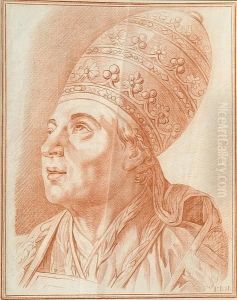Jean Francois De Neufforge Paintings
Jean Francois de Neufforge was a significant figure in the art world, particularly known for his contributions to architecture and engraving during the 18th century. Born in 1714, de Neufforge was a product of the Enlightenment era, a period that emphasized reason, science, and the importance of expressing human intellect through art, literature, and architecture. Throughout his career, de Neufforge dedicated his talents to the detailed study and representation of architectural forms, both ancient and contemporary, which he meticulously presented through his engravings.
De Neufforge's most notable work is 'Recueil élémentaire d'architecture,' an extensive collection of architectural designs and details published in multiple volumes starting from 1757. This work was not just a mere collection of designs; it was an encyclopedia of architectural elements, ranging from doors, windows, fireplaces, and even elaborate garden designs. 'Recueil élémentaire d'architecture' was instrumental in disseminating the ideas of Neoclassicism across Europe, influencing architects and designers by providing them with a rich source of inspiration and a guide to classical architectural principles.
His influence extended beyond the realm of professional architects and reached amateur builders and craftsmen, contributing significantly to the spread of Neoclassical architecture. De Neufforge's work was characterized by its precision and attention to detail, qualities that made his engravings highly valued among his contemporaries and later generations of architects and historians.
Despite his significant contributions, Jean Francois de Neufforge is not as widely known today as some of his contemporaries. However, his work remains a crucial reference for scholars and enthusiasts of 18th-century architecture, offering insights into the architectural tastes and trends of the Enlightenment period. De Neufforge died in 1791, leaving behind a legacy that continues to be appreciated in the fields of architectural history and historical engraving.
